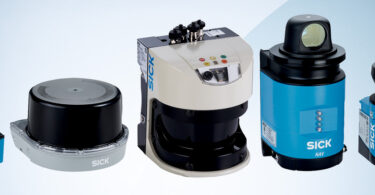Small mobile robots are quickly becoming important fixtures in intralogistics, and Lidar technology has helped move these robots forward. Lidar is not new to logistics – it has been used for collision avoidance and navigation in Automated Guided Vehicles (AGVs) for years. However, in some applications, an AGV is not a feasible solution and would require extensive modifications to the warehouse. For example, many traditional retail distribution warehouse aisles are too tight for an AGV to navigate, since the warehouses were originally designed for people rather than machines.
Does that mean a traditional warehouse will be unable to automate intralogistics and order fulfillment? Not at all! That’s where these smaller mobile robots have come in to fill the market need by combining a compact design with simple sensors and controllers for seamless autonomous navigation throughout the warehouse.
For example, freight, an autonomous mobile robot by Fetch Robotics, follows a human worker throughout the warehouse, allowing the worker to load orders onto the robot which then carries the items to the next location within the warehouse for shipping. The major benefits of these robots include minimal warehouse changes, customizable workflows, and increased efficiency.
For mobile intralogistics robots, Lidar is the best available technology for navigation and collision avoidance. Three advantages of Lidar technology are its immunity to ambient light, simultaneous location and mapping, and high resolution. These features allow the robot to adapt to the warehouse rather than modifying the warehouse for the robot.
1. Resistance to Ambient Light
An important benefit of Lidar versus other technologies is its resistance to ambient light. Other technologies—such as cameras—do not typically emit their own light signal, which means they are dependent on external sources of light to function properly. Changes in the light source—for example, if it gets too dark or too light when a window opens—can cause the camera to become confused causing the robot to act disoriented.
On the other hand, Lidar sends its own light signal, making it a much more active solution that does not heavily depend on maintaining a particular level of light. So, not only does Lidar work in the dark corners of a warehouse, it is also less likely to be blinded by bright lights while passing a sunny window. (Keep in mind that, if the robot will be regularly exposed to direct sunlight, you should choose Lidar rated for high sunlight resistance.)
2. Simultaneous Location and Mapping
Simultaneous Location and Mapping (SLAM) is a series of algorithms—used with both the TiM and LMS laser scanners from SICK—that interpret ranging data. This serves two essential purposes: 1) building a map of the robot’s surroundings and 2) locating the robot within that map. This functionality is crucial for path planning and dynamic obstacle avoidance (i.e. the ability to avoid an obstacle that suddenly appears in the robot’s path).
In other words, the robot needs to be able to actively monitor the location of obstacles and change its course. This is especially important in intralogistics applications where the robot interacts directly with a human worker.
For example, in the case of freight, the robot needs to maintain a following distance between itself and the human worker. It must also be able to come to a stop when the person stops to avoid collision and serve its purpose of having items loaded onto it for shipping.
3. High Resolution
Finally, Lidar technology has a much higher resolution than alternative technologies, making Lidar much more sensitive to small objects that might obstruct its path. SICK Lidar, in particular, uses High-Definition Distance Measurement (HDDM) to greatly increase the quality of data that it delivers.
HDDM uses up to 84 “micro-pulses” per measurement (1-degree or 1/3-degree) to increase the probability of detecting a small or difficult target. This SICK-patented technology gives the robot the ability to detect fine details at long distances, further enhancing the robot’s navigational capabilities.
This post was originally published in Lidar News and is republished by permission.





